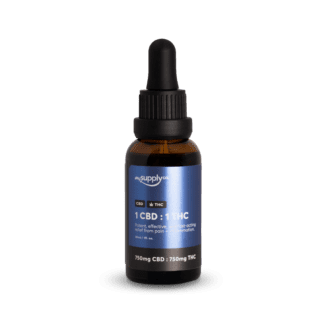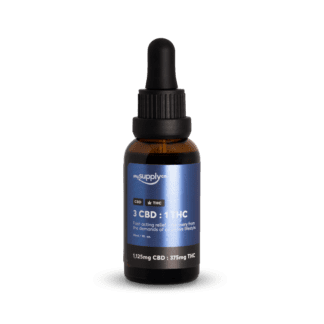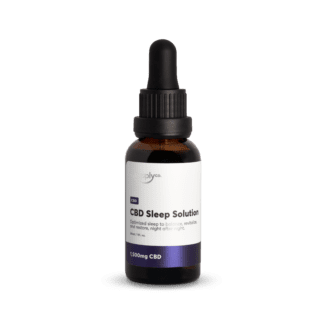In short, yes—read on for the science, or skip to the bottom for tips on the most common ratios, their effects, and how to choose yours.
Cannabidiol (CBD) and tetrahydrocannabinol (THC) are the two gold-star phytocannabinoids you haven’t stopped hearing about. The most important difference between the two is that CBD will not get you high, while THC does. Which is great news for your personal care routine.
However, research suggests that taking the two together—along with the 120+ organic compounds, phytocannabinoids, terpenes, and flavonoids found in a full-spectrum whole plant extract—is dramatically more effective than taking CBD or THC alone. It's why all our CBD products are formulated with hemp-extracted full-spectrum CBD, with the exception of our CBD Isolate.
But that’s not all. Because CBD also inhibits THC’s ability to bind with CB1 receptors, it can offset the dysphoria some experience with THC. When you start reaching ratios of 10 CBD : 1 THC, you can hardly notice THC's intoxicating effects. Instead of a high, it's more of an elevated feeling of bliss.
So, does that mean you should take CBD and THC together, or do they work just as well when taken separately? Read on to learn more.
What does the research say?
The best available science makes clear that whole-plant cannabis preparations are quantifiably superior to single compounds because the plant’s complex mix of phytocannabinoids, terpenes, and flavonoids interact synergistically to create the entourage effect.
- A study conducted at the California Pacific Medical Center in San Francisco found that combining THC and CBD produces more potent anti-tumor effects when tested on brain cancer and breast cancer cell lines than either compound alone.
- A 2010 study found that patients with intractable cancer-related pain tolerated medicines that combined THC and CBD notably better than a pure THC extract.
- A 2012 study in the Journal of Psychopharmacology found that CBD “inhibits THC-elicited paranoid symptoms and hippocampal-dependent memory impairment”
TAKING PHYTOCANNABINOIDS AND TERPENES TOGETHER MAY PROVIDE ADDITIONAL THERAPEUTIC BENEFITS
A number of conditions have been studied in conjunction with the entourage effect. A 2011 review of studies in the British Journal of Pharmacology found that taking terpenes and phytocannabinoids together may be particularly beneficial for:
- pain
- anxiety
- inflammation
- epilepsy
- cancer
- fungal infection
In what’s been described as “the largest study of its kind,” researchers at the University of New Mexico have been tracking cannabis users’ habits via an app: symptoms, cannabis product selections, and subsequent experience of relief (or not).
They found that cannabis users using the drug to soothe symptoms of nausea found relief in as quickly as five minutes—but they also found that users smoking joints of cannabis flower achieved more relief, and more quickly, than someone using a vaporizer or using edibles.
Most surprisingly, they also found that products with higher THC content were more effective than products high in CBD. In fact, users of cannabis products high in CBD achieved on average less symptom relief, according to research published in the Journal of Clinical Gastroenterology.
The study analyzed “2,220 cannabis self-administration sessions” from 886 users seeking relief from nausea between June 6, 2016 and July 8, 2019. Users reported what products they were using, what symptoms they were trying to alleviate, and then tracked how the cannabis product affected their symptoms in real time.
Interestingly, they found that flower products labeled sativa or hybrid “outperformed” products labeled indica (itself a flawed taxonomy, but that’s a separate story). And “In sessions using flower, higher tetrahydrocannbinol and lower cannabidiol were generally associated with greater symptom relief (eg, within 5 min),” the study authors reported.
While welcome news to anyone extolling THC’s medical benefits—and a fine opportunity to refine our understanding of CBD—the study isn’t all good news, the authors cautioned. THC’s long-term effects on “high-risk populations,” including pregnant women and children, who may be compelled to use cannabis, creates “concerns,” as study coauthor Dr. Sarah Stith, an assistant professor of economics at the University of New Mexico and the lead study author, said in a release.
It also bears mentioning that nausea is just one symptom, and that there are others that CBD is more effective in relieving than THC. For example, CBD helps reduce anxiety and promotes energy, mood, and focus by activating serotonin receptors, increasing anandamide levels, and regulating our body’s stress response.
But at the least, findings like this should promote a fuller understanding of cannabis and its constituent parts. It should also encourage anyone hearing the “THC for partying, CBD for healing” line to put it where it belongs: in the trash bin.
CBD MAY HELP REDUCE UNWANTED EFFECTS OF THC
Some people experience side effects like anxiety, hunger, and sedation after taking THC. Rat and human studies covered in the same 2011 review suggest that CBD may help reduce these side effects.
PHYTOCHEMICALS LIKE TERPENES AND FLAVONOIDS COULD BE BENEFICIAL TO BRAIN HEALTH
Research from 2018 found that certain flavonoids and terpenes may provide neuroprotective and anti-inflammatory effects. Researchers proposed that these compounds could improve CBD’s therapeutic potential.
MORE RESEARCH IS NEEDED
Like much of what we know about medical cannabis, the entourage effect is just a well-supported theory right now. And not all research has found evidence to support it.
A 2019 study tested six common terpenes both alone and in combination. The researchers found that the effects of THC on the cannabinoid receptors CB1 and CB2 were unchanged by the addition of terpenes.
This doesn’t mean that the entourage effect definitely doesn’t exist. It just means that more research is needed. It’s possible that terpenes interface with THC elsewhere in the brain or body, or in a different way.
What ratio of THC to CBD is best?
Is there even a best? The answer is “no,” which means you’ll need to experiment to see how it impacts you. While it may be that THC and CBD work better together than alone, it’s important to remember that cannabis affects everyone differently—and everyone’s goals for cannabis use are different.
A person with Crohn’s disease who uses cannabis-based medicine for nausea relief will probably have a different ideal ratio of THC to CBD than a weekend warrior who uses it for muscle pain. There’s no one dosage or ratio that works for everyone.
Here is a quick overview of common CBD to THC ratios (CBD is mentioned first) and their likely effects.
- 1 CBD : 4 THC: This is high-THC territory and is not for individuals with a low tolerance. You WILL feel stoned. Depending on the strain, you could feel energetic or completely sedated.
- 1 CBD : 2 THC: You have already entered intoxication territory, especially if you are a novice. You can expect to feel light-headed and euphoric.
- 1 CBD : 1 THC: This is considered the ideal balance by many researchers. You will probably experience a moderate level of intoxication.
- 3 CBD : 1 THC: Most users feel energized and clear-minded at this level. The CBD blocks most of the ‘high’ that THC would otherwise provide.
- 10 CBD : 1 THC: Once you go to this ratio, you’re unlikely to experience much of a high. This is an excellent daytime option.
- 20 CBD : 1 THC: At this level and beyond, there is practically no chance of intoxication. Indeed, you’re getting towards the ratio offered by some CBD oils derived from hemp. These could have 5% CBD against 0.25% THC, for example, thus remaining within the Farm Bill’s rules.
Tips for trying CBD and THC.
- Start with a low dose and increase if needed.
- For THC, try 5 milligrams (mg) or less if you’re a beginner or infrequent user.
- For CBD, try 10 to 20mg for mild to moderate conditions, and 40+ for severe conditions.
- Experiment with timing to see what works for you. You may find that taking THC and CBD at the same time works best. Or, you may prefer using CBD after THC.
- Try different delivery methods. CBD and THC can be taken in a number of ways, including:
- capsules
- gummies
- food products
- tinctures
- topicals
- vapes
Is CBD still beneficial without THC?
Some people don’t want to take THC, but are interested in trying CBD. There’s still plenty of research that suggests CBD may be beneficial by itself.
If you want to try CBD but don’t want to take THC, look for a CBD isolate product rather than a full-spectrum CBD product. Full-spectrum CBD products contain a broad range of cannabinoids and may have up to 0.3 percent THC. That’s not enough to produce a high, but it could still show up on a drug test.
Before you make a purchase, be sure to check the ingredients to be sure of what you’re getting.
Takeaway.
Cannabinoids and terpenoids in cannabis are thought to interact with each other as well as the brain’s receptors. This interaction has been labeled the entourage effect.
There’s some evidence that the entourage effect makes taking THC and CBD together more effective than either alone.
However, the entourage effect is still a theory. More research into the cannabis plant and its chemical composition is needed before we can know the full extent of its potential medical benefits.
Read: How to Choose a CBD : THC Ratio
Read: CBD vs. THC for Pain: Which Is Better, and for What?
Read: The Entourage Effect: More Than the Sum of its Parts
Read: Why the Endocannabinoid System is the Key to Health
Read: CB1 and CB2: Cannabinoid Receptors of the Brain and Body
Read: The Endocannabinoid System: What Drives Cannabis Around The Human Body?
Shop now.
-
 15003000
15003000
1 CBD : 1 THC Oil
Science-backed relief from pain and inflammation
-
 15003000
15003000
1:1 Sleep Solution
Deep, Tranquil, Pain-Free Sleep
-
 15003000
15003000
3 CBD : 1 THC Oil
Science-backed relief from pain and inflammation
-
 15003000
15003000
CBD Sleep Solution
Sleep + Brain Health + Stress Support
-
 15003000
15003000
Full Spectrum | CBD Oil
Balance Everything. Daily Stress, Anxiety, & Depression Management




